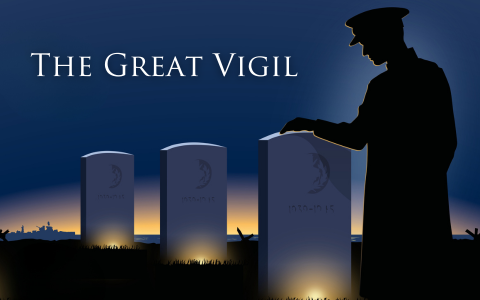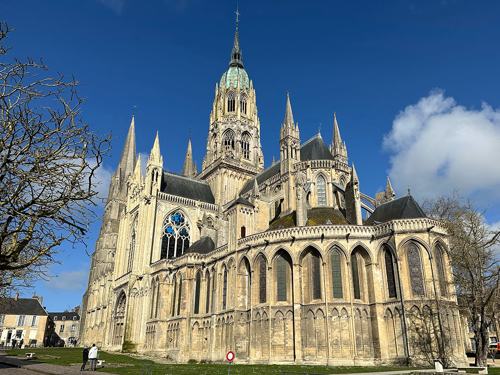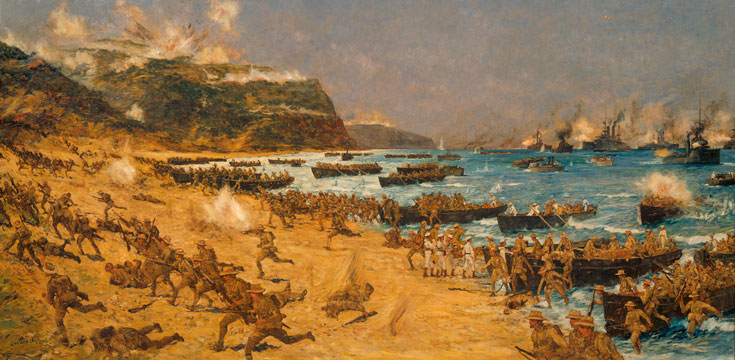29 April 2024
D-Day Memorials WW2: A visitor’s guide
Thinking of visiting the D-Day memorials of Normandy? Here’s what you need to know.
D-Day War Memorials – History & significance

Image: Two headstones at Ranville War Cemetery highlight the cost of the Normandy campaign
As we approach the Normandy 80th anniversary, the region remains full of reminders of the events of D-Day, Operation Overlord and the Normandy campaign.
None are more powerful than the many of D-Day memorials and cemeteries that dot Normandy’s former battlefields.
June 6, 1944, is a day steeped in historical significance. On this day, D-Day, the Allies launched Operation Overlord: the invasion of Normandy. This major campaign was one of the Second World War’s definitive events, leading to the Allied victory in Europe.
The battle of Normandy came at a cost. In the D-Day landings alone, over 4,000 Allied servicemen lost their lives. Commonwealth casualties from the UK and Canada make up around half that total.
During Operation Overlord, stretching from June to August 1944, the Allies took around 225,000 casualties. Total Commonwealth casualties are estimated at around 22,000 killed or missing.
It’s these men who are commemorated at D-Day cemeteries and memorials, as well as the sites commemorating the dead of the whole Normandy Campaign.
Through their actions, Europe was freed from the shackles of Nazi occupation, with the tragic loss of life a reminder of the price of liberation.
War memorials, whether commemorating D-Day and Normandy or other conflicts and campaigns, are an important focal point for commemoration, thanksgiving, and remembrance.
For many, they are a tangible link to the past, a real-time connection to families and relatives now sadly lost. Millions make the pilgrimage to war memorials and military cemeteries worldwide to engage and remember their relatives' actions.
In this way, D-Day Normandy memorials play an important role in linking the events of the past with the present.
D-Day Memorial facts
- There are 27 major military cemeteries in Normandy.
- Commonwealth War Graves Commission maintains war graves at over 300 locations in four Normandy departments, including D-Day memorials, individual burials, and purpose-built war cemeteries.
- Bayeux War Cemetery is the largest Commonwealth military cemetery in France with over 4,000 Commonwealth burials.
- The largest military cemetery in Normandy is La Cambe German War Cemetery, which holds over 21,000 war graves.
- The newest D-Day memorial in the region is the British Normandy Memorial, which opened on 6 June 2021.
Notable D-Day memorials to visit
British Normandy Memorial
The British Normandy Memorial is one of the most recently built Normandy D-Day memorials.
It was unveiled on the 77th anniversary of Operation Overlord on June 6, 2021. It commemorates over 22,000 men and women under British Command who lost their lives on D-Day and the wider Normandy Campaign.
The British Normandy Memorial is not a Commonwealth War Graves Commission site. However, in 2021, we agreed to take up the care and maintenance of the memorial on behalf of its owners The Normandy Memorial Trust.
The Normandy Memorial Trust was established in 2016. Its goal was to realise the dreams of Normandy veterans to create a single British memorial commemorating the dead of D-Day in one location.
The memorial is located at Ver-sur-Mer on the Normandy Coast, perched atop an imposing site overlooking Gold Beach. Gold Beach was one of five D-Day landing beaches and one of three assigned to the Commonwealth Forces.

Image: The British Normandy Memorial
Designed by architect Liam O’Connor, the memorial’s design features 160 stone columns arranged around a rectangular courtyard. The 22,000 or so names adorn these stone columns.
A bronze statue of British infantrymen, designed by David William-Ellis, sits outside the memorial’s entrance.
Within the memorial lies the Normandy Memorial Wall. This lists the servicemen who died on D-Day itself.
Unlike CWGC memorials, many of the men listed here have war graves, maintained by the Commonwealth War Graves Commission in our Normandy war cemeteries.
Commonwealth War Graves has agreed to maintain and care for the British Normandy Memorial. Our expert stonemasons, gardeners and maintenance teams will be using over a century of accumulated knowledge to care for this D-Day memorial to our usual exceptionally high standards.
Portsmouth Naval Memorial
Portsmouth Naval Memorial stands proudly on Southsea Common, overlooking the sea lanes entering Portsmouth.
Both memorial and landmark, Portsmouth Naval Memorial was designed to be an easily identifiable object for vessels returning home.
Over 24,650 men and women of the Royal Navy are commemorated by name on the memorial, 15,000 of which are from the Second World War.
Some 2,230 Royal Navy personnel, including Royal Marines Commandoes, were killed on D-Day or in the naval component of the Battle of Normandy.
Portsmouth Naval Memorial is one of three Royal Navy memorials in the UK, alongside Chatham and Plymouth.
The men and women commemorated by these memorials have no known grave but the sea. Each memorial symbolically brings them home for commemoration on British soil.

Image: Portsmouth Naval Memorial
Portsmouth Naval Memorial was designed by Sir Robert Lorimer with sculpture work from Henry Poole.
Following the Second World War, it was expanded to include 15,000 souls lost at sea during the conflict. The expansion was designed by Sir Edward Maufe with additional sculptures from Charles Wheeler, William McMillan, and Esmond Burton.
For the 75th anniversary of D-Day in 2019, Portsmouth Memorial was given a comprehensive restoration, including:
- Complete re-bronzing of the memorial’s name panels
- More than two kilometres of repointing
- Protection of the Grade-1 listed building’s masonry
- Thorough horticultural works and refreshment
D-Day could not have succeeded without the Royal Navy. The Landing craft were launched from Royal Navy vessels (or US ships in the case of American troops). With their big guns, Royal Navy ships pounded the German Atlantic Wall defences to aid the infantry assault and landings.
Ahead of D-Day itself, minesweepers were active in the Channel, clearing the way for the Invasion fleet. Before, during and after the Normandy Landings, the Royal Navy was busy on escort duty, protecting important cargo ships supplying the ground effort, as well as transporting soldiers to the continent.
Portsmouth has very strong ties to D-Day. It was the headquarters and main departure point for the forces assigned to Sword Beach, for instance. Southwick House, north of the city, was also used by Supreme Allied Commander General Dwight D. Eisenhower as his HQ before the invasion.
D-Day Cemeteries to visit
Bayeux War Cemetery

Image: Bayeux War Cemetery and War Memorial
Bayeux War Cemetery is the largest Second World War Commonwealth War Graves Commission site in France.
Over 4,000 Commonwealth graves of the Second World War lie alongside more than 500 of other nationalities, mostly German, within the cemetery.
Bayeux was the first French town of importance to be captured following the Normandy landings, although fighting there was mercifully brief and small. Bayeux thus became a staging ground for dead and wounded soldiers.
The cemetery was completed in 1952, bringing in graves from the surrounding area, including casualties taken during the earliest moments of the Battle for Normandy, including some killed on Sword Beach itself.
The Bayeux Memorial within the grounds of the war cemetery commemorates a further 1,800 Commonwealth servicemen with no known grave.
Bayeux War Cemetery has become a focal point for D-Day anniversary events. Many commemorations have been marked here, including the 60th and 70th anniversaries, with ceremonies led by Her Majesty Queen Elizabeth II.
Beny-sur-Mer Canadian War Cemetery

Image: Beny-sur-Mer Canadian War Cemetery
The 3rd Canadian Division hit Juno Beach on the morning of June 6th 1944, behind schedule and slightly off course thanks to the rising tide and choppy weather.
Well defended, the beach was much more of a killing field than Sword or Gold, with the Canadians losing 1,400 men, 340 killed.
Despite their tough start, the Canadians fought their way inland and by the end of D-Day, they had made the most progress inland than any Allied force.
Beny-sur-Mer Canadian War Cemetery is one of two Canadian military cemeteries in Normandy commemorating war dead of Operation Overlord. It holds over 2,000 burials, marking the heavy toll the Normandy campaign took on the Canadians.
Within Beny-sur-Mer lie 300 burials from D-Day, representing nearly all the Canadians killed on that day of days.
The other Canadian Military Cemetery related to Operation Overlord is Bretteville-sur-Laize Canadian War Cemetery.
Most of the 2,870 burials here are Canadian servicemen, killed in the latter stages of the Normandy Campaign, following the capture of Caen and the closing of the Falaise Gap.
Ranville War CemeterY

Image: Ranville War Cemetery
Ranville War Cemetery contains some of the earliest D-Day war graves.
Ranville was one of the first villages to be liberated in France when British airborne troops captured the bridge over the Caen Canal, now known as Pegasus Bridge, in the early hours of the Normandy invasion.
Today Ranville War Cemetery holds just over 2,400 burials, including a high number of Airborne war graves.
Memorial design & architecture
Commonwealth War Graves Commission cemeteries and memorials are easily identifiable.
Our architecture and memorial design are a familiar sight when it comes to commemorating the dead of D-Day and beyond.
Our headstones and their distinct shape set us apart from other nations. Headstones of United States troops, for instance, are cross-shaped.
No two Commission cemeteries are the same but they do have some unifying elements and common features that make them distinctly CWGC.

Image: The Stone of Remembrance at Bayeux War Cemetery
The first is the Stone of Remembrance. Designed by Sir Edwin Lutyens, the Stone of Remembrance’s altar-like appearance was a symbol of common sacrifice.
Secular design language was carefully used in this case, as the Commission is duty-bound to commemorate all servicemen equally, regardless of religion or creed.
That said, the other major CWGC architectural element draws heavily on Christian imagery: The Cross of Sacrifice.

Image: D-Day Veterans parade regimental flags around Bayeux War Cemetery's Cross of Sacrifice during the 60th anniversary events.
Designed by Sir Reginald Blomfield, The Cross of Sacrifice acts as a further remembrance focal point. Regarding the design, Blomfield wrote:
“What I wanted to do in designing this cross was to make it as abstract and impersonal as I could, to free it from association with any particular style, and, above all, to keep clear of any of the sentimentalities of Gothic. This was a man’s war too terrible for any fripperies, and I hoped to get within range of the infinite in this symbol of the ideals of those who had gone out to die.”
The British Normandy Memorial was not designed by Commonwealth War Graves but it does bear the influence of our memorial architecture.
The font used to inscribe the names upon the memorial’s commemorative columns is very similar to the typography used on our sites, for example.
The British Normandy Memorial is also constructed of white limestone blocks. Limestone is a key construction material for CWGC sites, although we source ours from Portland in southern England. The Normandy Memorial is constructed of French massangis limestone.
Is there a memorial for D-Day?
The British Normandy Memorial functions as the British national D-Day memorial.
Several other nations have their own D-Day memorials in France or on their home soil. The United States National D-Day Memorial, for instance, is in Bedford, Virginia although there is a memorial in the Normandy American Memorial.
These sites are not CWGC sites. Commonwealth War Graves instead commemorates the Commonwealth’s war dead of Normandy at purpose-built cemeteries and memorials throughout the region, rather than a single point of commemoration.
Where is the British D-Day Memorial?
The British D-Day Memorial is located at Ver-sur-Mer on the Normandy Coast, overlooking the site of Gold Beach.
The closest Commonwealth War Graves Commission war cemetery to the British Normandy Memorial is Ryes War Cemetery, accessible by a 12-minute car journey.
Where are the D-Day Memorials in Normandy, France?
The memorials and cemeteries related to D-Day are scattered across Normandy.
You can use our Find Cemeteries & War Memorials tool to find them. Choose “France” as your search country and select one of “Orne”, “Calvados”, “Seine-Maritime”, “Eure”, and “Manche” to find our Normandy sites.
Commemorating the D-Day 80th Anniversary
The Legacy of Liberation marks the 80th anniversary of several pivotal moments of the Second World War.

Lighting their Legacy
Across the UK, May & June
Discover our national programme of events and inspire the next generation.

The Great Vigil
Normandy, 5 June
Join the culmination of our D-Day events as we illuminate every CWGC grave in Normandy.

DISCOVER OUR 80TH ANNIVERSARY WW2 EVENTS
We're holding a number of events across the UK and in Normandy in the build up to the 80th anniversary of D-Day. Find out more about what we're planning and discover how you can get involved.
Find out moreThere are many reasons why we remember someone. Whether its as part of a large group on anniversaries like ANZAC Day or Remembrance Sunday, or privately on birthdays and other special occasions, Remembrance happens across the world each and every day. In our blog, we often highlight a few of the stories of Remembrance and pay tribute to those we have lost.




